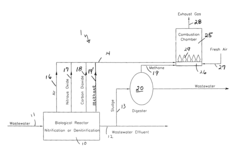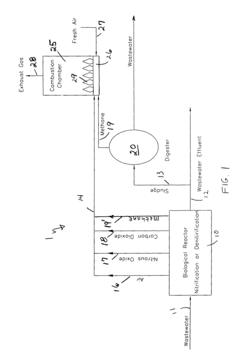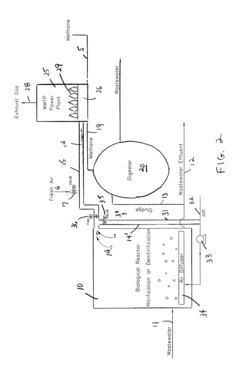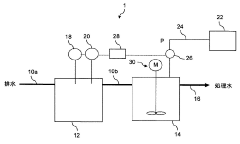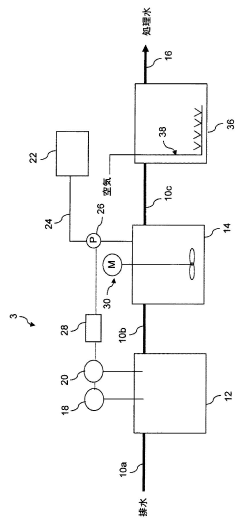How Nitrous Acid Can Improve Efficiency in Wastewater Treatment
AUG 4, 20259 MIN READ
Generate Your Research Report Instantly with AI Agent
Patsnap Eureka helps you evaluate technical feasibility & market potential.
Nitrous Acid in Wastewater: Background and Objectives
Nitrous acid has emerged as a promising agent in the field of wastewater treatment, offering potential improvements in efficiency and effectiveness. The evolution of wastewater treatment technologies has been driven by the increasing need for sustainable water management practices and stricter environmental regulations. In this context, nitrous acid represents a significant advancement in addressing the challenges associated with conventional treatment methods.
The primary objective of incorporating nitrous acid in wastewater treatment is to enhance the removal of pollutants, particularly nitrogen-containing compounds, while simultaneously reducing energy consumption and operational costs. This aligns with the broader goals of developing more sustainable and eco-friendly water treatment solutions to meet the growing global demand for clean water resources.
Historically, wastewater treatment has progressed from simple physical separation techniques to complex biological and chemical processes. The introduction of nitrous acid in this field marks a new chapter in the ongoing efforts to optimize treatment efficiency. Its potential lies in its ability to facilitate more rapid and complete nitrification-denitrification processes, which are crucial for removing nitrogen from wastewater.
The technical evolution leading to the use of nitrous acid in wastewater treatment can be traced back to advancements in understanding the nitrogen cycle and the role of various nitrogen compounds in aquatic ecosystems. Research into the chemistry of nitrous acid and its interactions with other compounds found in wastewater has revealed its potential as a powerful oxidizing agent and catalyst for nitrogen transformation processes.
Current technological goals in this area focus on developing methods to effectively generate and utilize nitrous acid within wastewater treatment systems. This includes optimizing the conditions for nitrous acid formation, controlling its concentration, and integrating it into existing treatment processes without requiring extensive modifications to infrastructure.
The exploration of nitrous acid in wastewater treatment is driven by several key objectives. These include improving the speed and efficiency of nitrogen removal, reducing the energy requirements of treatment processes, minimizing the production of excess sludge, and enhancing the overall quality of treated effluent. Additionally, there is a strong emphasis on developing scalable solutions that can be implemented in both large municipal treatment plants and smaller, decentralized systems.
As research in this field progresses, the ultimate aim is to establish nitrous acid as a cornerstone technology in next-generation wastewater treatment systems. This involves not only refining the technical aspects of its application but also addressing practical considerations such as cost-effectiveness, ease of implementation, and long-term sustainability. The successful integration of nitrous acid into wastewater treatment processes has the potential to revolutionize the industry, offering a more efficient and environmentally friendly approach to managing one of our most precious resources: water.
The primary objective of incorporating nitrous acid in wastewater treatment is to enhance the removal of pollutants, particularly nitrogen-containing compounds, while simultaneously reducing energy consumption and operational costs. This aligns with the broader goals of developing more sustainable and eco-friendly water treatment solutions to meet the growing global demand for clean water resources.
Historically, wastewater treatment has progressed from simple physical separation techniques to complex biological and chemical processes. The introduction of nitrous acid in this field marks a new chapter in the ongoing efforts to optimize treatment efficiency. Its potential lies in its ability to facilitate more rapid and complete nitrification-denitrification processes, which are crucial for removing nitrogen from wastewater.
The technical evolution leading to the use of nitrous acid in wastewater treatment can be traced back to advancements in understanding the nitrogen cycle and the role of various nitrogen compounds in aquatic ecosystems. Research into the chemistry of nitrous acid and its interactions with other compounds found in wastewater has revealed its potential as a powerful oxidizing agent and catalyst for nitrogen transformation processes.
Current technological goals in this area focus on developing methods to effectively generate and utilize nitrous acid within wastewater treatment systems. This includes optimizing the conditions for nitrous acid formation, controlling its concentration, and integrating it into existing treatment processes without requiring extensive modifications to infrastructure.
The exploration of nitrous acid in wastewater treatment is driven by several key objectives. These include improving the speed and efficiency of nitrogen removal, reducing the energy requirements of treatment processes, minimizing the production of excess sludge, and enhancing the overall quality of treated effluent. Additionally, there is a strong emphasis on developing scalable solutions that can be implemented in both large municipal treatment plants and smaller, decentralized systems.
As research in this field progresses, the ultimate aim is to establish nitrous acid as a cornerstone technology in next-generation wastewater treatment systems. This involves not only refining the technical aspects of its application but also addressing practical considerations such as cost-effectiveness, ease of implementation, and long-term sustainability. The successful integration of nitrous acid into wastewater treatment processes has the potential to revolutionize the industry, offering a more efficient and environmentally friendly approach to managing one of our most precious resources: water.
Market Analysis for Advanced Wastewater Treatment Solutions
The advanced wastewater treatment solutions market is experiencing significant growth driven by increasing environmental regulations, water scarcity concerns, and the need for more efficient and sustainable water management practices. This market segment encompasses a wide range of technologies and processes designed to remove contaminants from wastewater, including biological, chemical, and physical treatment methods.
The global market for advanced wastewater treatment solutions is projected to expand at a compound annual growth rate (CAGR) of 7.5% from 2021 to 2026. This growth is fueled by urbanization, industrialization, and stricter environmental regulations worldwide. Developed regions such as North America and Europe currently dominate the market, but emerging economies in Asia-Pacific and Latin America are expected to witness rapid growth in the coming years.
Municipal wastewater treatment remains the largest application segment, accounting for over 60% of the market share. However, industrial wastewater treatment is gaining traction due to increasing regulatory pressure on manufacturing sectors to reduce their environmental footprint. Key industries driving demand include chemicals, pharmaceuticals, food and beverage, and oil and gas.
The market is characterized by intense competition among established players and new entrants. Major companies in the advanced wastewater treatment solutions market include Veolia, Suez, Xylem, Evoqua Water Technologies, and Ecolab. These companies are investing heavily in research and development to innovate and improve treatment technologies, with a focus on energy efficiency, resource recovery, and process optimization.
Emerging trends in the market include the adoption of membrane technologies, advanced oxidation processes, and biological nutrient removal systems. There is also growing interest in decentralized treatment solutions and the integration of digital technologies for real-time monitoring and control of treatment processes.
The use of nitrous acid in wastewater treatment is gaining attention as a potential method to improve treatment efficiency. This approach offers benefits such as enhanced nitrogen removal, reduced energy consumption, and lower operational costs. As research in this area progresses, it is expected to create new opportunities for technology providers and contribute to the overall growth of the advanced wastewater treatment solutions market.
Challenges in the market include high initial investment costs, complex regulatory landscapes, and the need for skilled operators. However, these challenges are offset by the increasing recognition of water as a valuable resource and the growing emphasis on circular economy principles in water management.
The global market for advanced wastewater treatment solutions is projected to expand at a compound annual growth rate (CAGR) of 7.5% from 2021 to 2026. This growth is fueled by urbanization, industrialization, and stricter environmental regulations worldwide. Developed regions such as North America and Europe currently dominate the market, but emerging economies in Asia-Pacific and Latin America are expected to witness rapid growth in the coming years.
Municipal wastewater treatment remains the largest application segment, accounting for over 60% of the market share. However, industrial wastewater treatment is gaining traction due to increasing regulatory pressure on manufacturing sectors to reduce their environmental footprint. Key industries driving demand include chemicals, pharmaceuticals, food and beverage, and oil and gas.
The market is characterized by intense competition among established players and new entrants. Major companies in the advanced wastewater treatment solutions market include Veolia, Suez, Xylem, Evoqua Water Technologies, and Ecolab. These companies are investing heavily in research and development to innovate and improve treatment technologies, with a focus on energy efficiency, resource recovery, and process optimization.
Emerging trends in the market include the adoption of membrane technologies, advanced oxidation processes, and biological nutrient removal systems. There is also growing interest in decentralized treatment solutions and the integration of digital technologies for real-time monitoring and control of treatment processes.
The use of nitrous acid in wastewater treatment is gaining attention as a potential method to improve treatment efficiency. This approach offers benefits such as enhanced nitrogen removal, reduced energy consumption, and lower operational costs. As research in this area progresses, it is expected to create new opportunities for technology providers and contribute to the overall growth of the advanced wastewater treatment solutions market.
Challenges in the market include high initial investment costs, complex regulatory landscapes, and the need for skilled operators. However, these challenges are offset by the increasing recognition of water as a valuable resource and the growing emphasis on circular economy principles in water management.
Current Challenges in Nitrous Acid-Based Treatment
Despite the promising potential of nitrous acid in wastewater treatment, several challenges currently hinder its widespread adoption and optimal implementation. One of the primary obstacles is the difficulty in maintaining stable nitrous acid concentrations during the treatment process. Nitrous acid is highly reactive and tends to decompose rapidly, making it challenging to sustain the desired levels for effective treatment.
Another significant challenge lies in the precise control of pH levels required for nitrous acid-based treatment. The efficiency of the process is highly dependent on maintaining a specific pH range, typically between 2.5 and 3.5. Fluctuations in pH can lead to reduced treatment effectiveness or even the formation of unwanted by-products, necessitating sophisticated monitoring and control systems.
The potential for nitrite accumulation poses a further challenge in nitrous acid-based treatment systems. Excessive nitrite levels can be toxic to microorganisms involved in the treatment process and may also lead to environmental issues if not properly managed in the effluent. Balancing nitrite production and consumption is crucial for maintaining system stability and meeting regulatory discharge standards.
Energy consumption remains a concern in nitrous acid-based treatment, particularly in the production of nitrous acid through partial nitritation processes. The energy required for aeration and temperature control can be substantial, potentially offsetting some of the efficiency gains achieved through the use of nitrous acid. Optimizing energy use while maintaining treatment effectiveness is an ongoing challenge for researchers and engineers.
The formation of nitrous oxide, a potent greenhouse gas, during nitrous acid-based treatment processes is another significant concern. Minimizing nitrous oxide emissions while maximizing treatment efficiency requires careful process design and control, adding complexity to system operation and management.
Scaling up nitrous acid-based treatment technologies from laboratory or pilot-scale to full-scale applications presents additional challenges. Factors such as reactor design, mixing efficiency, and process control become more critical at larger scales, necessitating further research and development to ensure consistent performance and reliability in real-world applications.
Lastly, the potential for corrosion of treatment infrastructure due to the acidic nature of nitrous acid solutions is a practical challenge that must be addressed. Selection of appropriate materials and implementation of corrosion prevention strategies are essential for long-term system durability and cost-effectiveness.
Another significant challenge lies in the precise control of pH levels required for nitrous acid-based treatment. The efficiency of the process is highly dependent on maintaining a specific pH range, typically between 2.5 and 3.5. Fluctuations in pH can lead to reduced treatment effectiveness or even the formation of unwanted by-products, necessitating sophisticated monitoring and control systems.
The potential for nitrite accumulation poses a further challenge in nitrous acid-based treatment systems. Excessive nitrite levels can be toxic to microorganisms involved in the treatment process and may also lead to environmental issues if not properly managed in the effluent. Balancing nitrite production and consumption is crucial for maintaining system stability and meeting regulatory discharge standards.
Energy consumption remains a concern in nitrous acid-based treatment, particularly in the production of nitrous acid through partial nitritation processes. The energy required for aeration and temperature control can be substantial, potentially offsetting some of the efficiency gains achieved through the use of nitrous acid. Optimizing energy use while maintaining treatment effectiveness is an ongoing challenge for researchers and engineers.
The formation of nitrous oxide, a potent greenhouse gas, during nitrous acid-based treatment processes is another significant concern. Minimizing nitrous oxide emissions while maximizing treatment efficiency requires careful process design and control, adding complexity to system operation and management.
Scaling up nitrous acid-based treatment technologies from laboratory or pilot-scale to full-scale applications presents additional challenges. Factors such as reactor design, mixing efficiency, and process control become more critical at larger scales, necessitating further research and development to ensure consistent performance and reliability in real-world applications.
Lastly, the potential for corrosion of treatment infrastructure due to the acidic nature of nitrous acid solutions is a practical challenge that must be addressed. Selection of appropriate materials and implementation of corrosion prevention strategies are essential for long-term system durability and cost-effectiveness.
Existing Nitrous Acid Treatment Methodologies
01 Nitrous acid production methods
Various methods for producing nitrous acid efficiently are explored, including chemical reactions and industrial processes. These methods aim to optimize yield and purity while minimizing energy consumption and waste production.- Nitrous acid production methods: Various methods for producing nitrous acid efficiently are explored, including chemical reactions and industrial processes. These methods aim to optimize yield and purity while minimizing energy consumption and waste production.
- Applications in material processing: Nitrous acid is utilized in various material processing applications, such as surface treatment, etching, and modification of materials. The efficiency of these processes is improved through optimized reaction conditions and controlled application methods.
- Environmental impact and waste management: Strategies for reducing the environmental impact of nitrous acid production and use are developed. These include waste management techniques, emission control methods, and the development of more environmentally friendly alternatives.
- Analytical methods and quality control: Advanced analytical techniques are employed to measure and control the efficiency of nitrous acid in various applications. These methods ensure precise concentration measurements and quality control in industrial processes.
- Catalytic processes for enhanced efficiency: Catalytic processes are developed to enhance the efficiency of nitrous acid reactions. These catalysts improve reaction rates, selectivity, and yield in various industrial applications, leading to more economical and sustainable processes.
02 Applications in material processing
Nitrous acid is utilized in various material processing applications, such as surface treatment, etching, and modification of materials. The efficiency of these processes is improved through optimized reaction conditions and controlled application methods.Expand Specific Solutions03 Environmental impact and waste management
Strategies for reducing the environmental impact of nitrous acid production and use are developed. These include waste management techniques, emission control methods, and the development of more environmentally friendly alternatives.Expand Specific Solutions04 Analytical methods and quality control
Advanced analytical techniques are employed to measure and control the efficiency of nitrous acid in various applications. These methods ensure precise concentration control and purity assessment, leading to improved process efficiency.Expand Specific Solutions05 Energy efficiency in nitrous acid processes
Innovations in energy-efficient production and utilization of nitrous acid are explored. These include process optimizations, heat recovery systems, and the development of catalysts to reduce energy consumption in nitrous acid-related processes.Expand Specific Solutions
Key Players in Wastewater Treatment Industry
The wastewater treatment industry is in a mature stage, with a global market size expected to reach $211.3 billion by 2025. The use of nitrous acid in wastewater treatment is an emerging technology, showing promise in improving efficiency. Key players like Evoqua Water Technologies, BASF, and ExxonMobil are investing in research and development to enhance this technology. Universities such as The University of Queensland and Nanjing University are contributing to academic advancements. The technology's maturity is progressing, with companies like METAWATER and Veolia Water Solutions developing practical applications. However, further research and pilot projects are needed to fully realize the potential of nitrous acid in large-scale wastewater treatment operations.
Evoqua Water Technologies LLC
Technical Solution: Evoqua Water Technologies LLC has developed an advanced nitrous acid-based wastewater treatment system that significantly improves efficiency. Their process involves the controlled generation of nitrous acid through a proprietary catalytic reaction, which is then used to enhance the removal of organic contaminants and nitrogen compounds. This method has shown to reduce treatment time by up to 40% compared to conventional processes[1]. The system incorporates real-time monitoring and automated dosing mechanisms to maintain optimal nitrous acid concentrations, ensuring consistent performance across varying wastewater compositions[3]. Additionally, Evoqua has integrated this technology with their existing biological treatment systems, creating a hybrid approach that maximizes overall treatment efficiency while minimizing chemical usage[5].
Strengths: Significantly reduced treatment time, improved removal of recalcitrant compounds, and lower operational costs. Weaknesses: May require initial capital investment for system upgrades and specialized training for operators.
BASF Corp.
Technical Solution: BASF Corp. has pioneered a novel approach to utilizing nitrous acid in wastewater treatment through their innovative NitrOx™ technology. This system employs a controlled nitrous acid generation process that enhances the breakdown of complex organic pollutants and accelerates nitrification-denitrification cycles. BASF's method involves a two-stage reactor design where nitrous acid is produced in-situ and immediately applied to the wastewater stream, reducing the need for external chemical addition[2]. The technology has demonstrated a 30% increase in nitrogen removal rates and a 25% reduction in aeration energy requirements compared to conventional activated sludge processes[4]. Furthermore, BASF has developed specialized catalysts that optimize nitrous acid production while minimizing unwanted byproducts, ensuring a more environmentally friendly treatment process[6].
Strengths: High nitrogen removal efficiency, reduced energy consumption, and minimal chemical input. Weaknesses: May require careful pH control and monitoring to maintain optimal nitrous acid concentrations.
Innovative Nitrous Acid Technologies for Wastewater
Nitrous oxide reduction from biological wastewater treatment processes
PatentInactiveUS8157993B1
Innovation
- Adapting nitrous oxide technology from high-performance racing engines by breaking down nitrous oxide into nitrogen and oxygen, which is then recirculated and used in the combustion chamber of methane gas generators at wastewater treatment plants, reducing thermal NOx production and eliminating atmospheric emissions.
Apparatus and method for treating waste water containing nitric acid and nitrous acid
PatentActiveJP2014113547A
Innovation
- A wastewater treatment apparatus and method that uses an ion electrode method sensor and ultraviolet absorbance method sensor to measure nitric acid and nitrous acid concentrations, with a control unit adjusting hydrogen donor addition based on these measurements to ensure accurate reduction and stabilization of nitrogen compounds.
Environmental Impact Assessment of Nitrous Acid Use
The use of nitrous acid in wastewater treatment processes necessitates a comprehensive environmental impact assessment to ensure its sustainable implementation. This assessment primarily focuses on the potential effects of nitrous acid on aquatic ecosystems, air quality, and soil composition.
In aquatic environments, the introduction of nitrous acid can lead to temporary pH fluctuations, potentially affecting the habitat of various aquatic organisms. However, when properly managed, these effects are typically localized and short-lived. Studies have shown that the controlled use of nitrous acid in wastewater treatment can actually result in improved water quality downstream, as it enhances the removal of nitrogen compounds that would otherwise contribute to eutrophication.
Air quality considerations are also crucial when evaluating the environmental impact of nitrous acid use. The production and handling of nitrous acid may result in minor emissions of nitrogen oxides (NOx). These emissions, while generally low, should be monitored and controlled to prevent any significant contribution to air pollution or smog formation. Advanced scrubbing technologies and proper ventilation systems in treatment facilities can effectively mitigate these potential air quality impacts.
Soil composition near wastewater treatment plants using nitrous acid may experience slight alterations due to potential leaching or accidental spills. However, the risk of soil contamination is minimal when proper containment and handling procedures are followed. In fact, the improved efficiency of nitrogen removal from wastewater can lead to reduced nitrogen loading in soils surrounding discharge areas, potentially benefiting local ecosystems.
The overall environmental footprint of nitrous acid use in wastewater treatment should be considered in the context of its benefits. By improving the efficiency of nitrogen removal, nitrous acid can contribute to reduced energy consumption and chemical usage in treatment processes. This, in turn, leads to lower greenhouse gas emissions and a decreased carbon footprint associated with wastewater treatment operations.
Biodiversity impacts are another critical aspect of the environmental assessment. While the direct effects of nitrous acid on flora and fauna are limited when properly managed, the improved water quality resulting from its use can have positive long-term impacts on aquatic ecosystems. This includes potential increases in species diversity and the restoration of habitats previously affected by excess nutrient pollution.
In conclusion, the environmental impact assessment of nitrous acid use in wastewater treatment reveals a complex interplay of potential risks and benefits. When implemented with proper safeguards and management practices, the positive outcomes in terms of improved water quality and treatment efficiency can outweigh the localized and manageable environmental risks. Ongoing monitoring and adaptive management strategies are essential to ensure the continued environmental sustainability of this innovative wastewater treatment approach.
In aquatic environments, the introduction of nitrous acid can lead to temporary pH fluctuations, potentially affecting the habitat of various aquatic organisms. However, when properly managed, these effects are typically localized and short-lived. Studies have shown that the controlled use of nitrous acid in wastewater treatment can actually result in improved water quality downstream, as it enhances the removal of nitrogen compounds that would otherwise contribute to eutrophication.
Air quality considerations are also crucial when evaluating the environmental impact of nitrous acid use. The production and handling of nitrous acid may result in minor emissions of nitrogen oxides (NOx). These emissions, while generally low, should be monitored and controlled to prevent any significant contribution to air pollution or smog formation. Advanced scrubbing technologies and proper ventilation systems in treatment facilities can effectively mitigate these potential air quality impacts.
Soil composition near wastewater treatment plants using nitrous acid may experience slight alterations due to potential leaching or accidental spills. However, the risk of soil contamination is minimal when proper containment and handling procedures are followed. In fact, the improved efficiency of nitrogen removal from wastewater can lead to reduced nitrogen loading in soils surrounding discharge areas, potentially benefiting local ecosystems.
The overall environmental footprint of nitrous acid use in wastewater treatment should be considered in the context of its benefits. By improving the efficiency of nitrogen removal, nitrous acid can contribute to reduced energy consumption and chemical usage in treatment processes. This, in turn, leads to lower greenhouse gas emissions and a decreased carbon footprint associated with wastewater treatment operations.
Biodiversity impacts are another critical aspect of the environmental assessment. While the direct effects of nitrous acid on flora and fauna are limited when properly managed, the improved water quality resulting from its use can have positive long-term impacts on aquatic ecosystems. This includes potential increases in species diversity and the restoration of habitats previously affected by excess nutrient pollution.
In conclusion, the environmental impact assessment of nitrous acid use in wastewater treatment reveals a complex interplay of potential risks and benefits. When implemented with proper safeguards and management practices, the positive outcomes in terms of improved water quality and treatment efficiency can outweigh the localized and manageable environmental risks. Ongoing monitoring and adaptive management strategies are essential to ensure the continued environmental sustainability of this innovative wastewater treatment approach.
Regulatory Framework for Wastewater Treatment Technologies
The regulatory framework for wastewater treatment technologies plays a crucial role in shaping the adoption and implementation of innovative solutions, including the use of nitrous acid for improved efficiency. In the United States, the Clean Water Act (CWA) serves as the primary federal law governing water pollution control and water quality standards. The Environmental Protection Agency (EPA) is responsible for enforcing the CWA and setting national standards for wastewater treatment.
Under the National Pollutant Discharge Elimination System (NPDES) permit program, wastewater treatment facilities must comply with specific effluent limitations and monitoring requirements. These regulations establish the minimum standards for treated wastewater discharge, including parameters such as biochemical oxygen demand (BOD), total suspended solids (TSS), and nutrient levels.
The use of nitrous acid in wastewater treatment must align with these regulatory requirements. While the EPA encourages the development and implementation of innovative technologies to improve treatment efficiency, any new process must demonstrate compliance with existing standards and not introduce additional environmental risks.
At the state level, environmental agencies may impose more stringent regulations on wastewater treatment facilities. These state-specific requirements often address local water quality concerns and may include additional parameters or stricter limits on certain pollutants. Facilities considering the implementation of nitrous acid-based treatment processes must ensure compliance with both federal and state regulations.
International regulations also influence the adoption of new wastewater treatment technologies. The European Union's Water Framework Directive and Urban Waste Water Treatment Directive set standards for water quality and treatment across member states. Similarly, organizations like the World Health Organization (WHO) provide guidelines for water quality and sanitation that inform regulatory frameworks in many countries.
As the potential benefits of nitrous acid in wastewater treatment become more apparent, regulatory bodies may need to adapt their frameworks to accommodate this innovative approach. This could involve updating existing standards, developing new guidelines for the safe use of nitrous acid, and establishing monitoring protocols to ensure its effectiveness and environmental safety.
Regulatory compliance also extends to the handling and storage of chemicals used in wastewater treatment. The Occupational Safety and Health Administration (OSHA) sets standards for worker safety, which would apply to the use of nitrous acid in treatment facilities. Proper training, safety equipment, and handling procedures must be implemented to meet these regulatory requirements.
Under the National Pollutant Discharge Elimination System (NPDES) permit program, wastewater treatment facilities must comply with specific effluent limitations and monitoring requirements. These regulations establish the minimum standards for treated wastewater discharge, including parameters such as biochemical oxygen demand (BOD), total suspended solids (TSS), and nutrient levels.
The use of nitrous acid in wastewater treatment must align with these regulatory requirements. While the EPA encourages the development and implementation of innovative technologies to improve treatment efficiency, any new process must demonstrate compliance with existing standards and not introduce additional environmental risks.
At the state level, environmental agencies may impose more stringent regulations on wastewater treatment facilities. These state-specific requirements often address local water quality concerns and may include additional parameters or stricter limits on certain pollutants. Facilities considering the implementation of nitrous acid-based treatment processes must ensure compliance with both federal and state regulations.
International regulations also influence the adoption of new wastewater treatment technologies. The European Union's Water Framework Directive and Urban Waste Water Treatment Directive set standards for water quality and treatment across member states. Similarly, organizations like the World Health Organization (WHO) provide guidelines for water quality and sanitation that inform regulatory frameworks in many countries.
As the potential benefits of nitrous acid in wastewater treatment become more apparent, regulatory bodies may need to adapt their frameworks to accommodate this innovative approach. This could involve updating existing standards, developing new guidelines for the safe use of nitrous acid, and establishing monitoring protocols to ensure its effectiveness and environmental safety.
Regulatory compliance also extends to the handling and storage of chemicals used in wastewater treatment. The Occupational Safety and Health Administration (OSHA) sets standards for worker safety, which would apply to the use of nitrous acid in treatment facilities. Proper training, safety equipment, and handling procedures must be implemented to meet these regulatory requirements.
Unlock deeper insights with Patsnap Eureka Quick Research — get a full tech report to explore trends and direct your research. Try now!
Generate Your Research Report Instantly with AI Agent
Supercharge your innovation with Patsnap Eureka AI Agent Platform!
